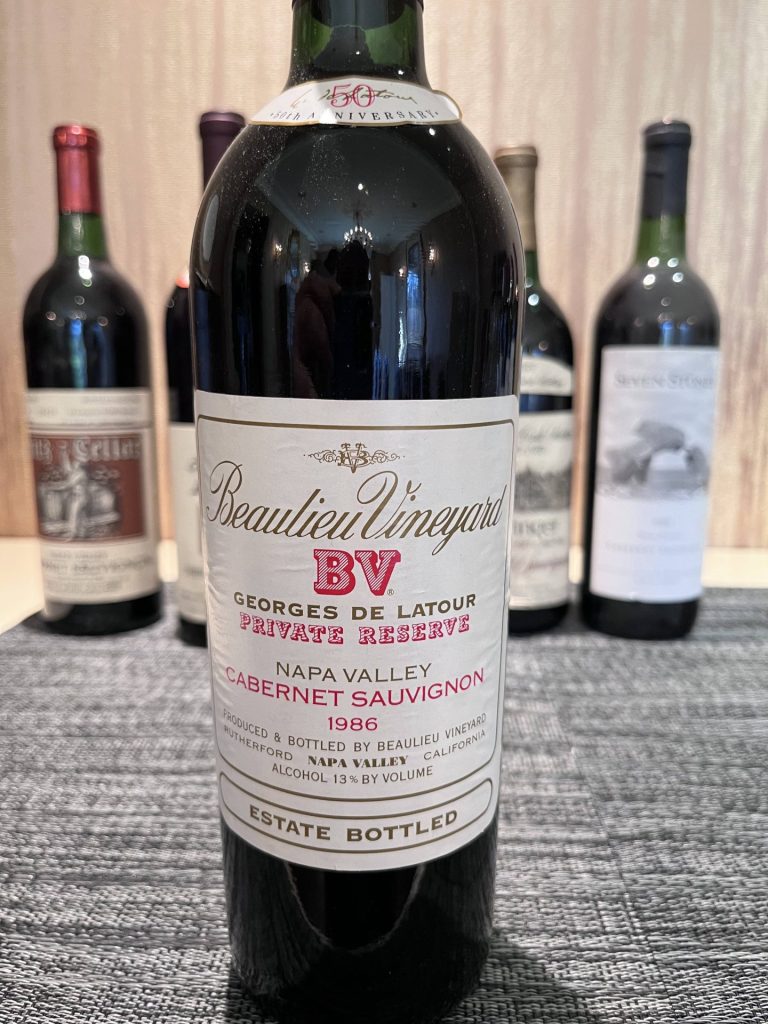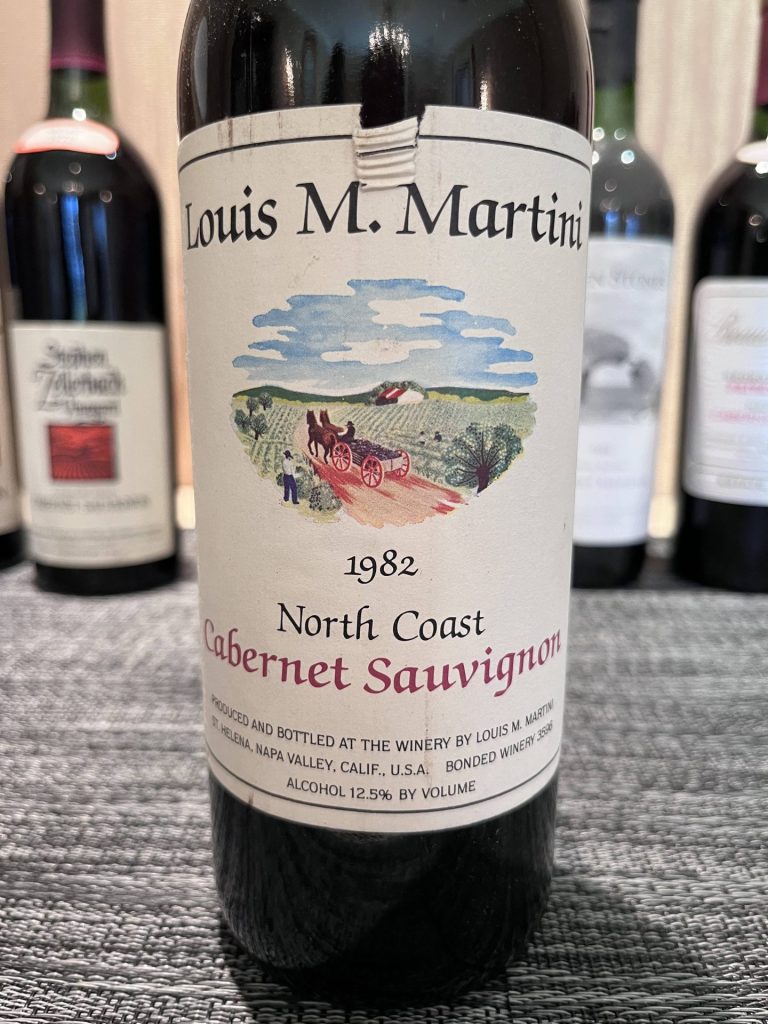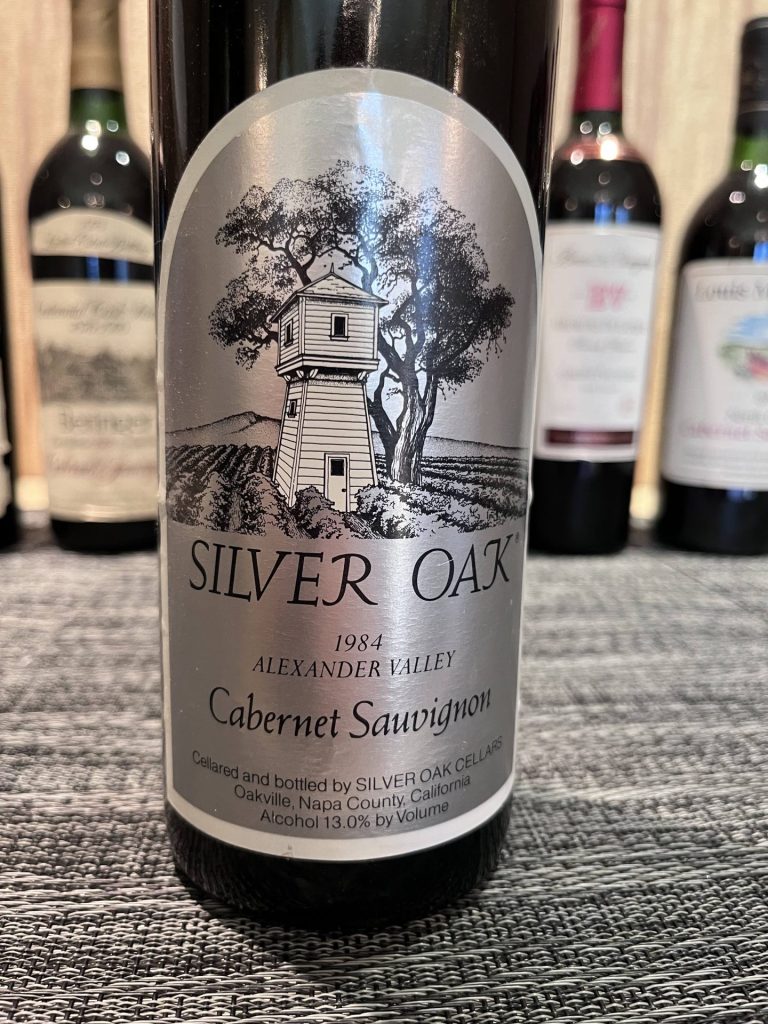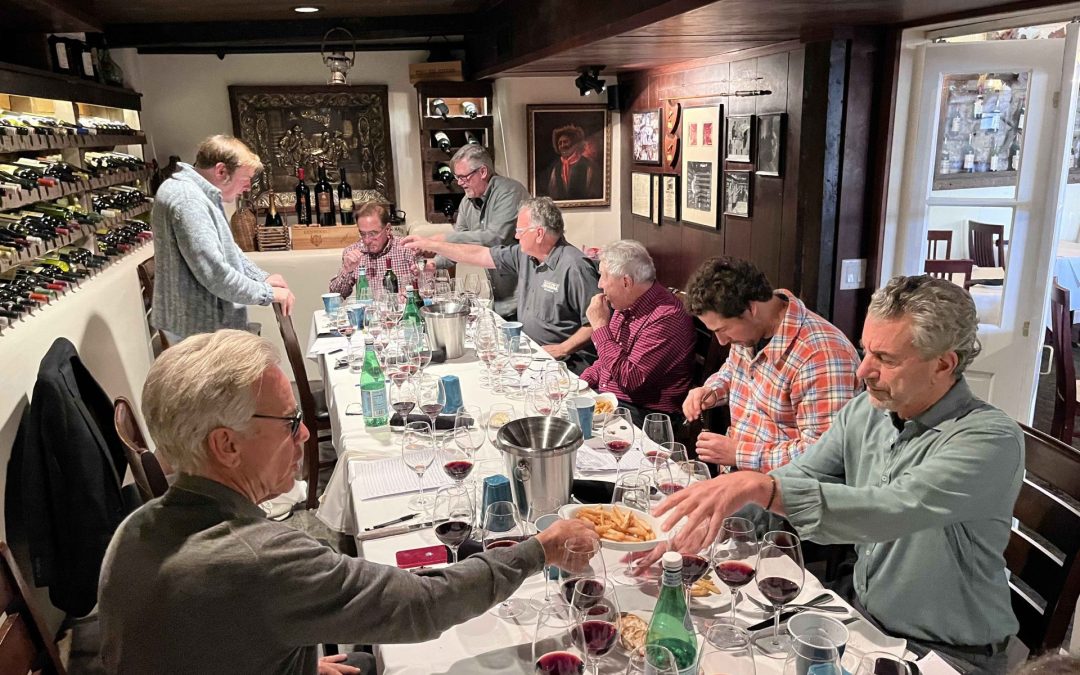
Feb 12, 2023 | Uncategorized
Barolos, considered ‘The King” of Italian wines:
Once again, at the invitation of Don Sebastiani, Sr., fellow Sonoma winemakers and somms gathered for a studious tasting. This time at the Swiss Hotel private dining room on the Plaza in downtown Sonoma. (Note: their Reuben Sandwich, fries, and an aged Barolo highly recommended)
Barolos are praised worldwide for their complex and powerful flavors of dried flowers (rose and violet), dried red fruit (strawberry and raspberry), licorice, tar and earth. From the Langhe area near Alba in Piedmont, Italy and based upon the Nebbiolo grape. Barolos are frequently aged 3 – 5 years before release.
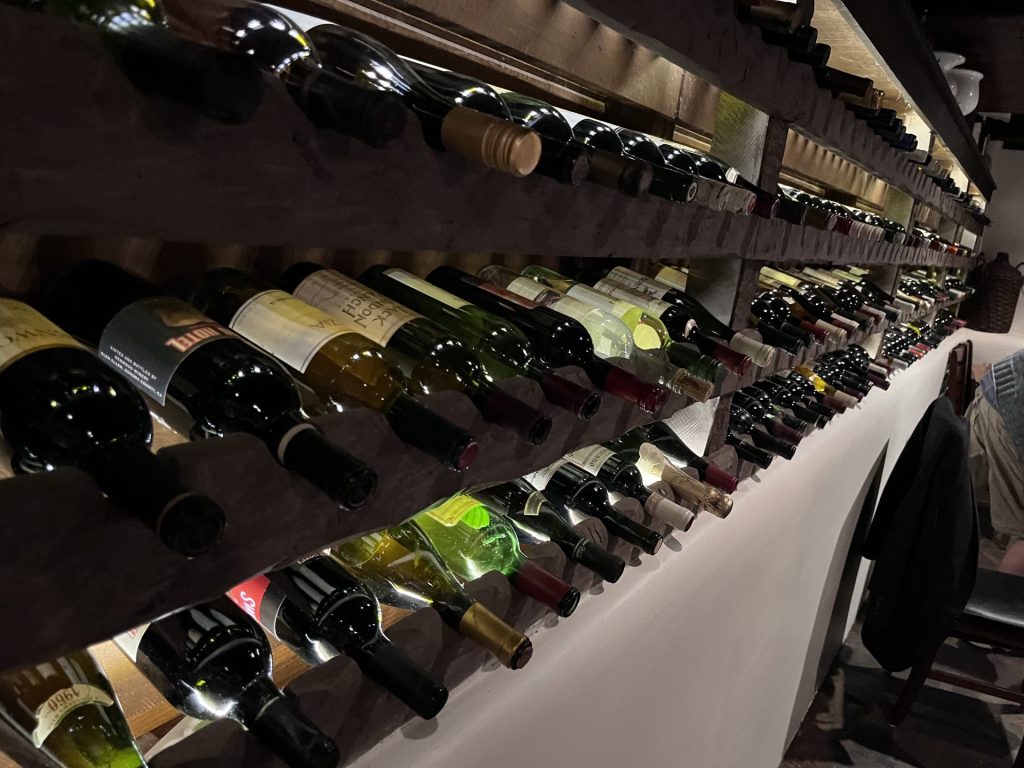
Wall of fame in the private dining room at the Swiss. Some bottles wait to be opened while other titans of wine were consumed long ago and now sit empty but ready to be re-admired.
The Barolos
What a hit parade of wines. I can genuinely recommend every one of these producers. It has been a long time since I was in a professional tasting where even the lowest ranked wines (since all wines are forced ranked) were wines everyone loved.

Conterno – Monfortino is a selection of the best fruit from the vineyards of Cascina Francia in Serralunga d’Alba.

Rinaldi – dried herbs, mint, sage, cedar, sweet pipe tobacco and gentle earthy notes
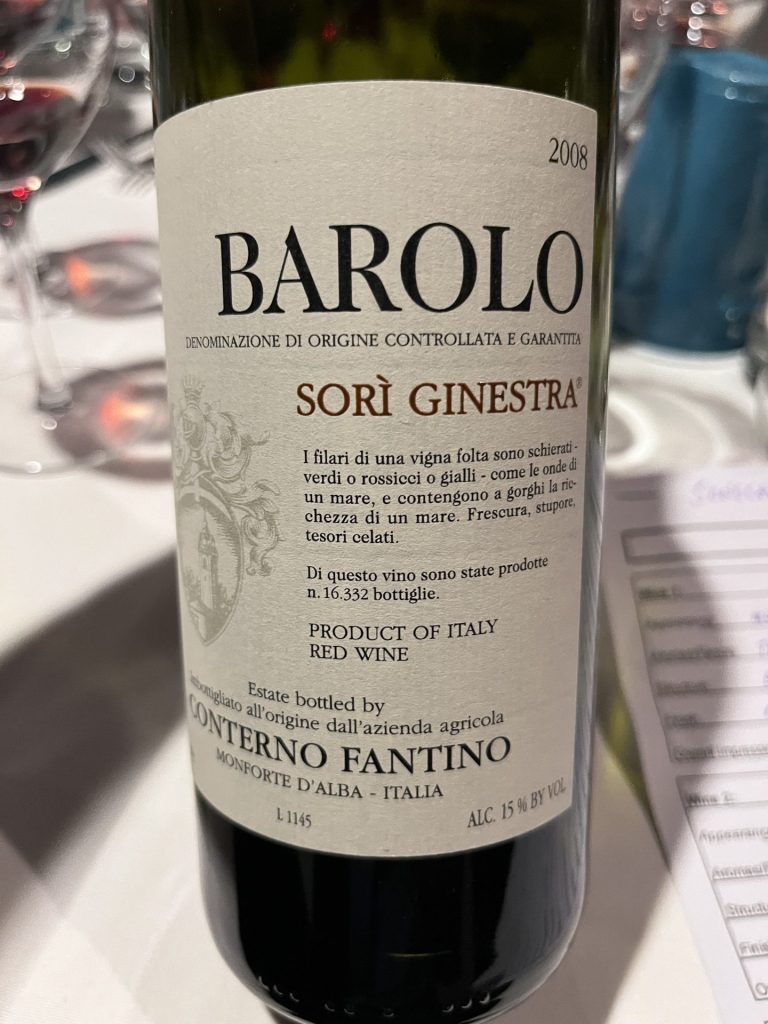
Conterno – Conterno Fantino winery was founded in 1982 by Claudio Conterno and Guido Fantino.

Falletto – Tarry underbrush, saddle leather, grilled meat, licorice in a subtle way. Balanced and still young palate with dried dark blackberry, subtle oak tones.

Falletto – Vibrant and fruity, yet with a solid structure, with additional depth from the earthy, smoky, tobacco and tar underneath. Bright acidity with polished tannins here, more expressive than Asili Riserva, but still need at least 5 years to mature beautifully.
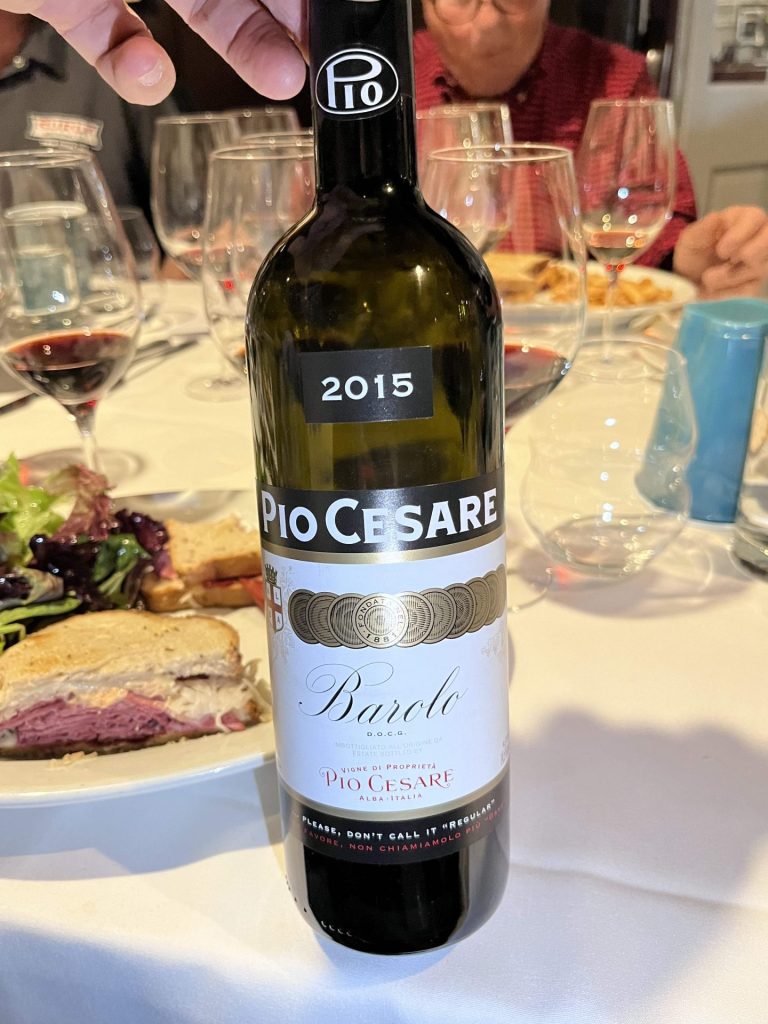
Pio Cesare – Complex aromas of smoke, ash and dark fruit with precision and intensity. Layered and gorgeous. Loads of dark fruit and perfume. Full-bodied with round and wonderfully polished tannins. Wonderful length and richness.
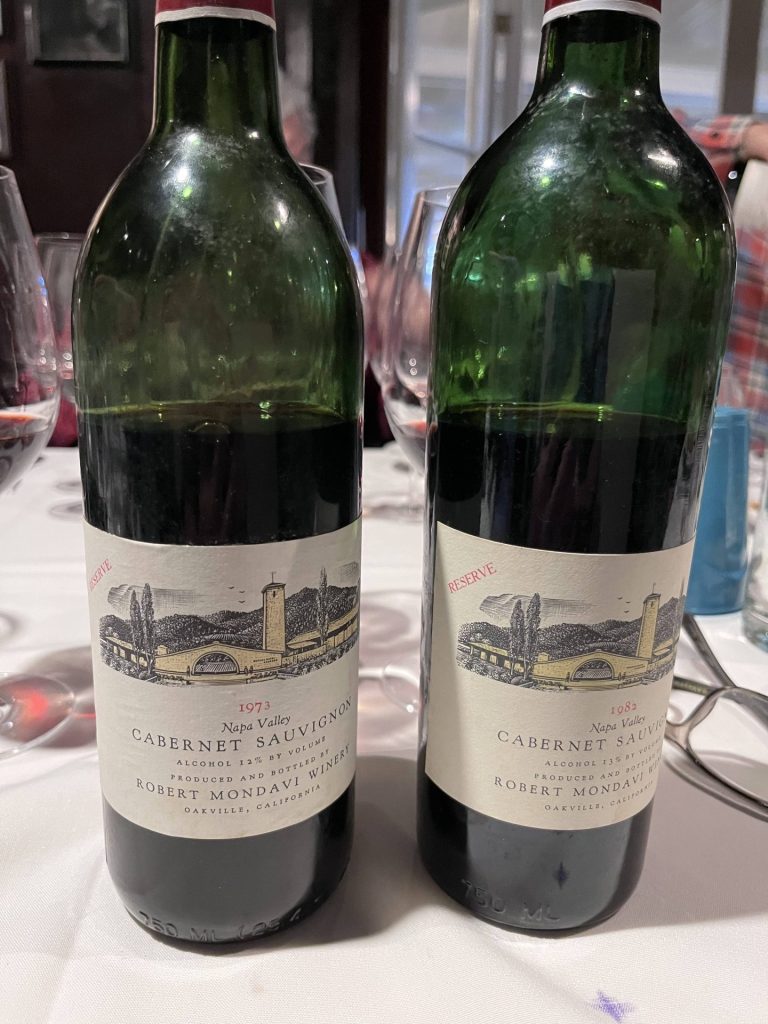
After the Barolos, these 3 special bottles were cracked open. Here, classic old Napa Valley Mondavi, 1973 and 1982. We all really enjoyed breaking down the way these were likely farmed – back in those decades when Napa was just getting rolling.

…and this Opus One, 1984, required decanting and was a bit curious, not everyone’s favorite, but worthy of note nonetheless.
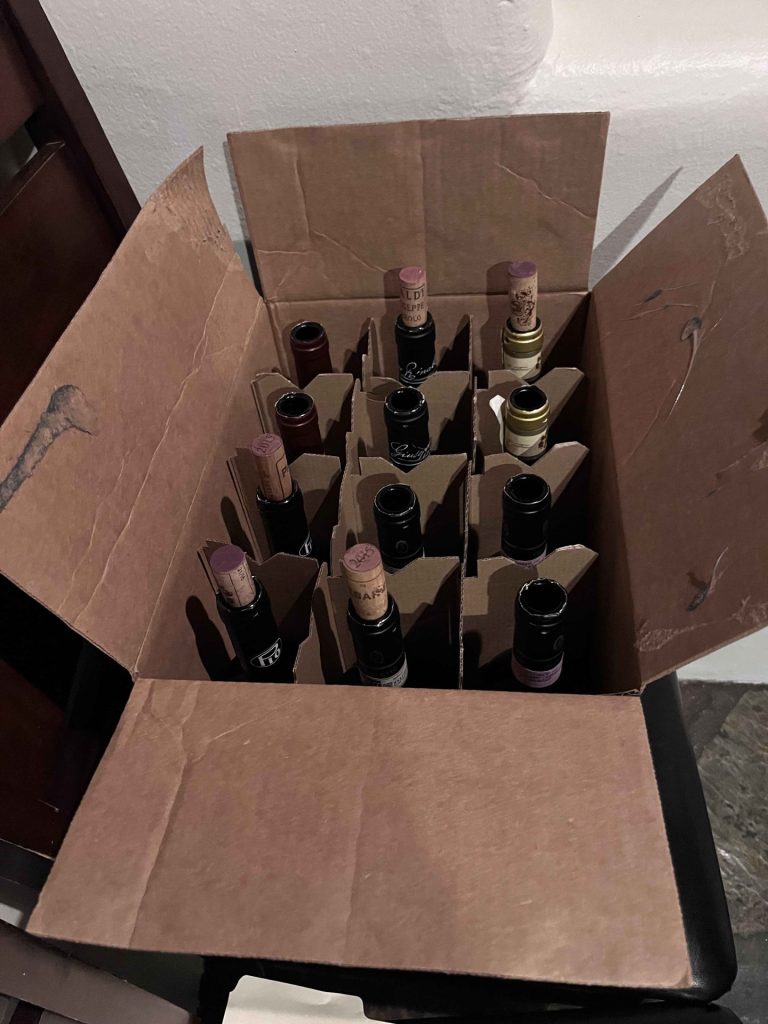
Bottles were revealed from this box of treasures.
Napa “Lighted Art” public street art festival
Went over to the ‘other’ valley on a Thursday eve to take in the light show. The Napa Lighted Art Festival is a celebration of creative arts, technology and lights, and supports innovative techniques using light and light technologies as a growing art medium. This walkable outdoor experience is FREE in downtown Napa featuring 10 lighted art sculptures for five weeks and projection artwork on 3 iconic downtown buildings for the first 9 nights of the festival. Bring the family and experience the magic of lighted art at the 2023 Napa Lighted Art Festival!
January 21st- February 19th, 2023, Monday- Thursday 6-9pm | Friday – Sunday 6-10pm
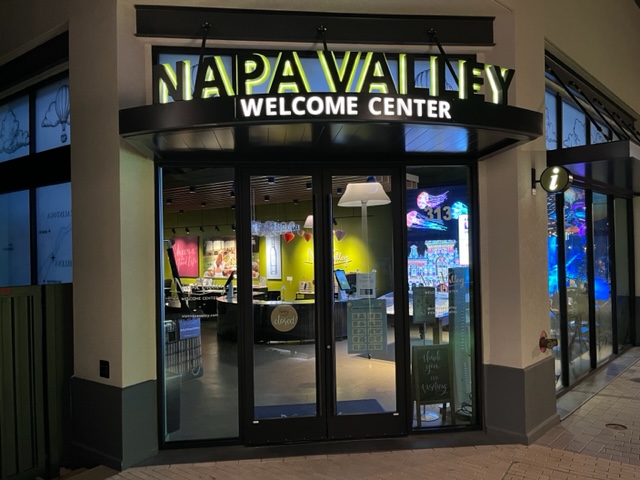
Started our tour here, where all night long they have docents at the ready to hand you a map of the installation locations.

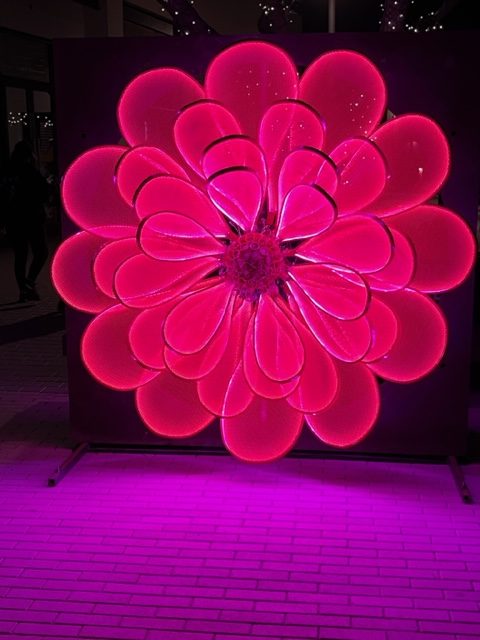



Throwback
A trip back in time when our little start-up Redwood City winery began winning some critic’s awards:
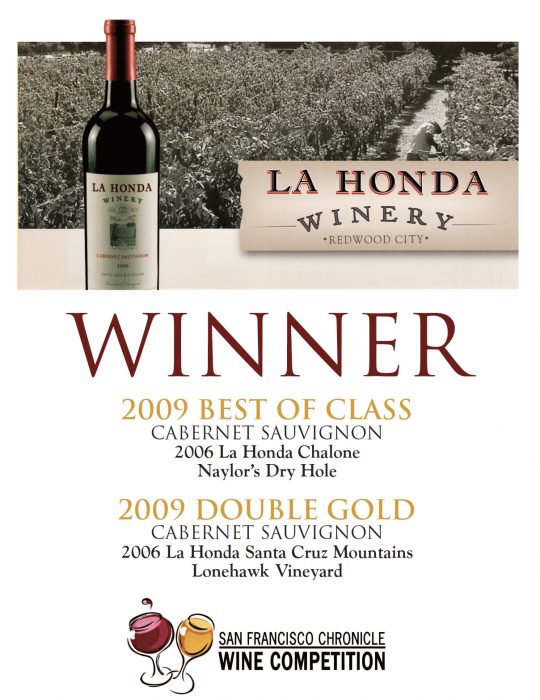
Sonoma International Film Festival – tickets now on sale – don’t miss it!

The best event of the entire Sonoma wine country calendar. This year, the Sonoma International Film Festival will be featuring special films from all over the world, in comfortable theater venues, with amazing sound. Don’t miss this extraordinary 5-day event.Buy your passes today. Click here.
Our “Sonocaia Estate Reserve Sagrantino” red wine is a proud sponsor. Please join us at the party!
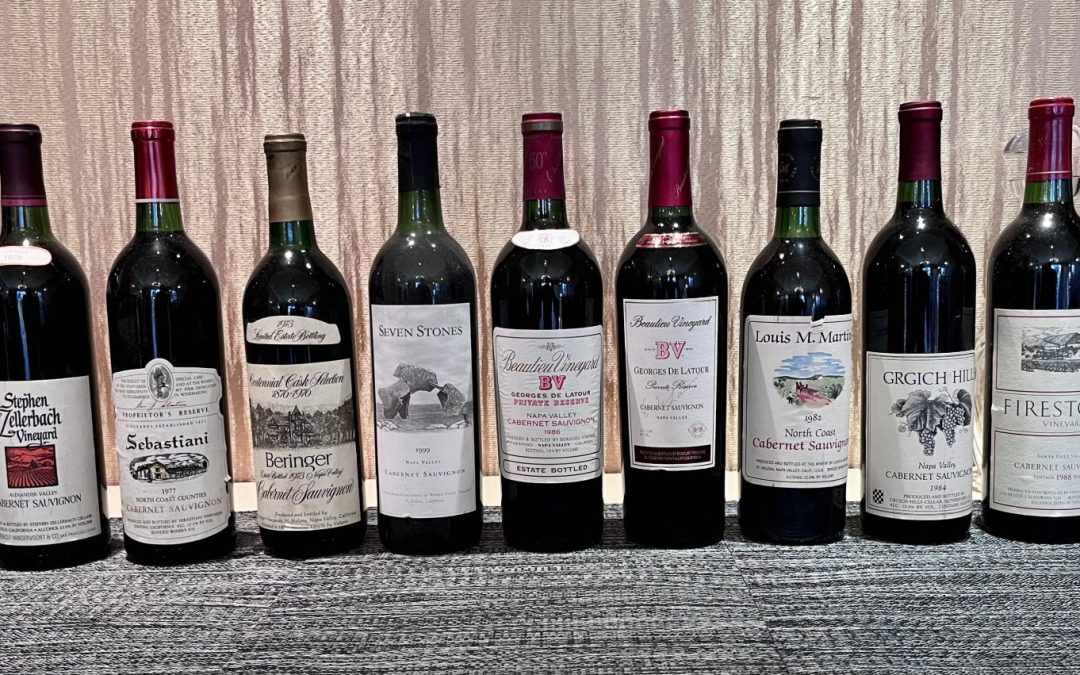
Jan 19, 2023 | California Cabernet, Sagrantino, Sebastiani, Sonoma lifestyle, Sonoma wine tasting panel, Uncategorized
The experts shock me with a surprising achievement in a crowded field of arguably the greatest of the older California Cabernets. Read the compelling story and see the results of our blind tasting:
25 – 50 year old California Cabernets (1973-1999)

Spoiler alert! Here is the end of the movie first. This photo is from the big reveal – after the tasting.
These 11 wines were carefully opened, decanted, bagged, numbered, and poured. These wines are mostly from my personal cellar from when I first became interested wine starting in my freshman year in college and up to my very first garage-made wine twelve years later.

Beringer, Cabernet, Napa Valley, Estate, ‘Centennial Cask Selection’, 1973
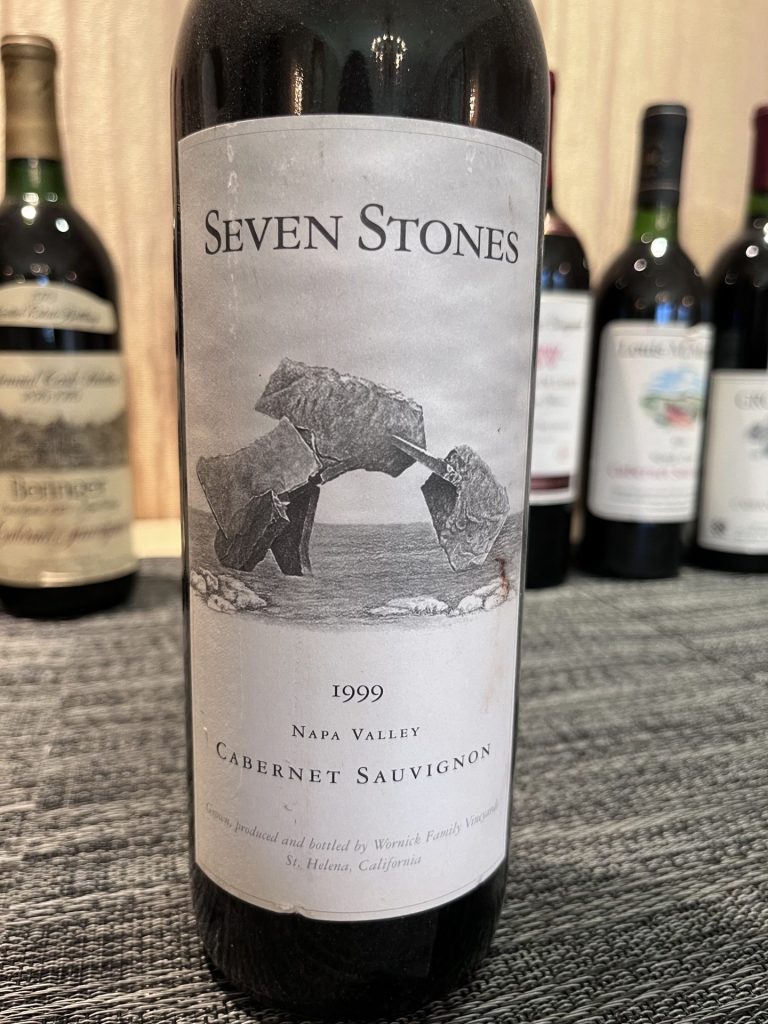
Seven Stones, Cabernet, Estate, Napa Valley, 1999 (the very first vintage, produced by me in the estate’s garage)
The results
Each taster scored their top 3 and bottom 1 wine (shown here).
The top half of this page is the individual scoring, the bottom half are the actual bottle codes. After the tasting and scoring, the list of wines was provided to the panel.
As a second thought experiment, before revealing the actual bottles, tasters attempted to match the 11 wines tasted to the printed list of 13 possible wines shown. The 2 French wines (from my father’s cellar) were not included in the tasting and were simply on the printed list as decoys – to see if anyone would take the bait. A few did.
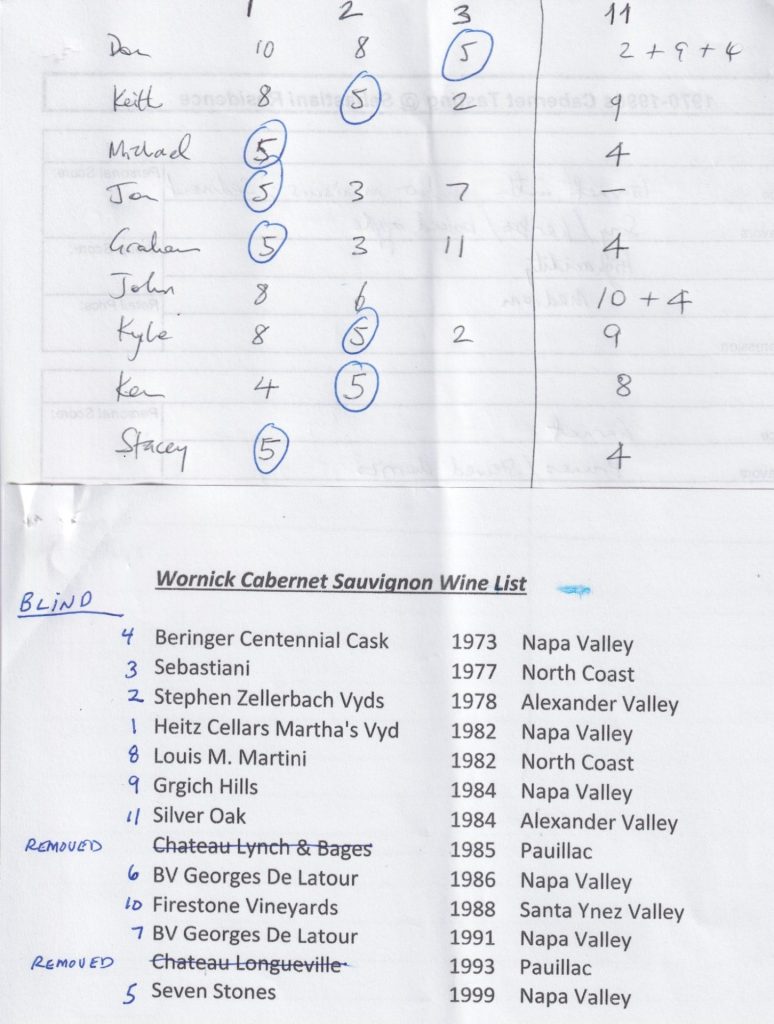
I could not believe my eyes! The clear winner? The 1999 Seven Stones! What? One of the first wines I ever produced. Not commercially either. Just made as a garage wine for our family.
Was this for real? Indeed it was.The tasting was absolutely blind. The results completely legitimate. Tabulations were scored by a very reliable accountant.
Story: The Seven Stones, Cabernet, Napa Valley, 1999 was the very first wine produced from the Seven Stones vineyard in St. Helena, Napa Valley. Planted by me in 1996 at my parent’s estate in St Helena. We were still living in Burlingame, Ca., and I had only just started my vineyard development business above Silicon Valley. That company is still operating, see this link: La Honda Winery and Post and Trellis Vineyards in Redwood City, California. The 1999 was one of the very first wines of my career – now 25 years ago. I didn’t have any formal equipment, fermented it in the garage, no drains, no press, no filter, just raw manual labor all the way through to hand bottling and labeling the 2 barrels, about 50 cases. The 1999 vintage was never sold to the public, only consumed by our family. There might be a dozen bottles still around. But the ’99 is what lead to the eventual commercialization of Seven Stones, which now garners incredibly high critic’s scores and sells out every year.
Side note: That 1999 Seven Stones was a combination of amazing grapes and some good luck. With an undergrad degree in geology, years of field work, followed by an MBA; a decade later I took a few extension courses at Davis. And interned for a few weeks during harvest at the vaunted Staglin Winery in Rutherford, Napa. The winemaker at that time was Andy Erickson, now of Screaming Eagle and Leviathan and Favia, among others. But I was the very lowest man on the totem pole and naturally spent the entire “learning experience” dragging hoses and cleaning tanks. Those are the rudimentary skills I had to apply to the 1999 vintage.
1970’s panel “Winners” and “Worst of the Best” – details on the scores (we were stunned, and if you weren’t there you might not believe it):
Best of the best:
- Seven Stones, Cabernet, Napa Valley, 1999 was the clear winner overall. I alone knew that Seven Stones was the somewhere in the lineup, but I didn’t know where? No one else had a clue that a Seven Stones wine was in the tasting until after the reveal. And as proof of the ‘blind’ results, I actually chose the group’s least favorite wine as my personal favorite (ever the contrarian, as you’ll see below). One note – to be completey fair, the 1999 Seven Stones was the youngest wine in the lineup, and perhaps therefore the ‘freshest.’
- Louis M Martini, North Coast, 1982 – with arguably the second highest scores, we all just about fell off of our chairs as this wine sold for $3.79 at the time and had a peel-off plastic capsule. But, the cork was in superb condition. It was considered a spaghetti-red table wine at the time and likely not ever intended to go up against these more expensive titans.
- Sebastiani, Cabernet, Proprietor’s Reserve, North Coast Counties, 1977 and Stephen Zellerbach Vineyard, Cabernet, Alexander Valley, 1978 were also in the running for favorite, as were several other wines vying for a place in the top 3. I was pleased for Don that his family’s wine showed so well. I was a nervous wreck knowing that our host’s family’s wine was hiding somewhere in that lineup.
Worst of Best: There really and truly were no bad wines. Not a single bottle was badly oxidized. And the ullage was excellent for all bottles:
- Beringer, Cabernet, Napa Valley, Estate, ‘Centennial Cask Selection’, 1973 – there was near unanimity in the group of this wine being the least favorite. This surprised me as I had posted it as my favorite wine. I felt it had fantastic aromas on the nose, and a depth of flavor, but others felt it was somewhat pruny and over the hill. Still available on some re-sale sites for $350.
- Grgich Hills, Cabernet, Napa Valley, 1984 – this wine garnered a few votes for least favorite. And the cork was in superb shape. So who knows? Grgich was and remains a well respected Napa winery. So many things contribute to the condition of a wine after 25-50 years. Found on some re-sale sites for $160-$300.
The Players

A pause in the action for a quick photo. At this point we’ve quietly tasted and made notes on 5 of the 11 wines. In this tasting, I invited some of my favorite colleagues from the wine world – winemakers, collectors, customers, and consultants. But I forgot to ask permission this time around, so I am afraid I cannot identity most of them.

Having a laugh: Stacey Clarke, Principal owner of Treehouse (the brand development company behind the spring 2023 launch of our Sonocaia estate Sagrantino) and me, Ken Wornick (Sonocaia, Dysfunctional Family, and Hydeout)
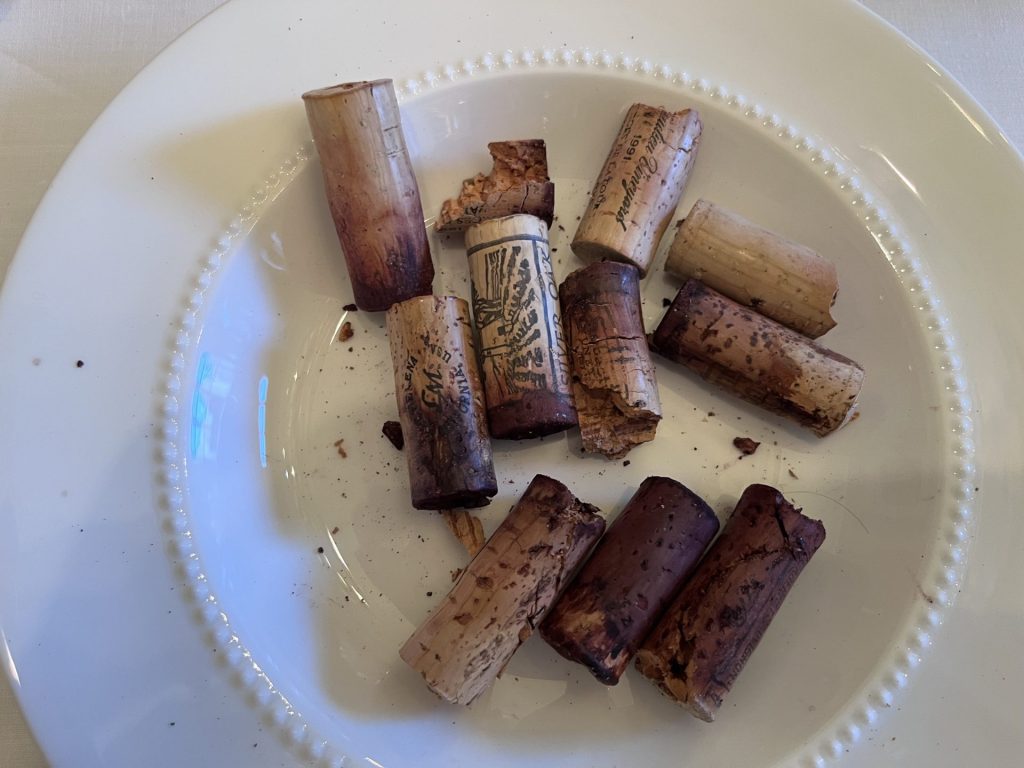
Many of the old corks were in very fine shape, likely due to the quality of the producers, and the excellent storage history, but a few disintegrated on contact and had to be very carefully extracted and wine decanted.
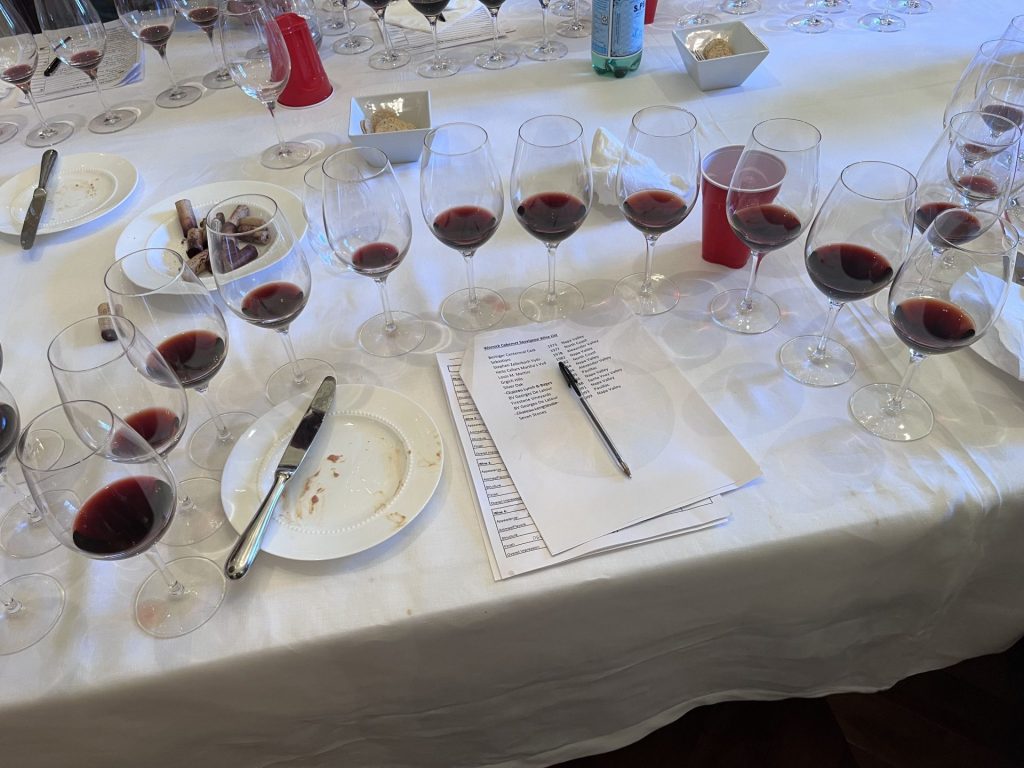
11 wines lined up and quietly tasted blind. Then tasters were supplied with a list of 13 wines, out of order, and had to guess which 11 wines were which.
Honorable mention – one of our winemaking colleagues brought a Hudson Valley Torchon Of Foie Gras (see the empty plate). It went so perfectly with our tasting. Also of note, the ducks are apparently not stuffed with feed (as with days of old). Their website says – the Moulard is a cross between the white farm duck, the Pekin, and a South American duck, the Muscovy. The Pekin has a mild flavor; the Muscovy, a gamy flavor. When the two breeds are crossed, they produce a high quality, deliciously unique flavor sought after by the finest chefs worldwide. Moulard ducks have a special ability to store fat in the liver. Like the Muscovy, they are ground-foraging ducks. Moulards don’t fly and are not fans of open water. These characteristics make the Moulard the ideal breed for producing foie gras.. The website says: Don’t Sweat the technique! The Torchon of Foie Gras is the ultimate cold preparation. Translating to “Towel” in French, its name is a result of the preparation method where the Foie Gras was traditionally tied in a kitchen towel, rolled, poached, and hung to chill for several days. The torchon of Foie Gras is a labor of love that we have refined for your convenience and enjoyment. Its cylindrical shape makes for an easy and impressive slice & serve that is guaranteed to delight.
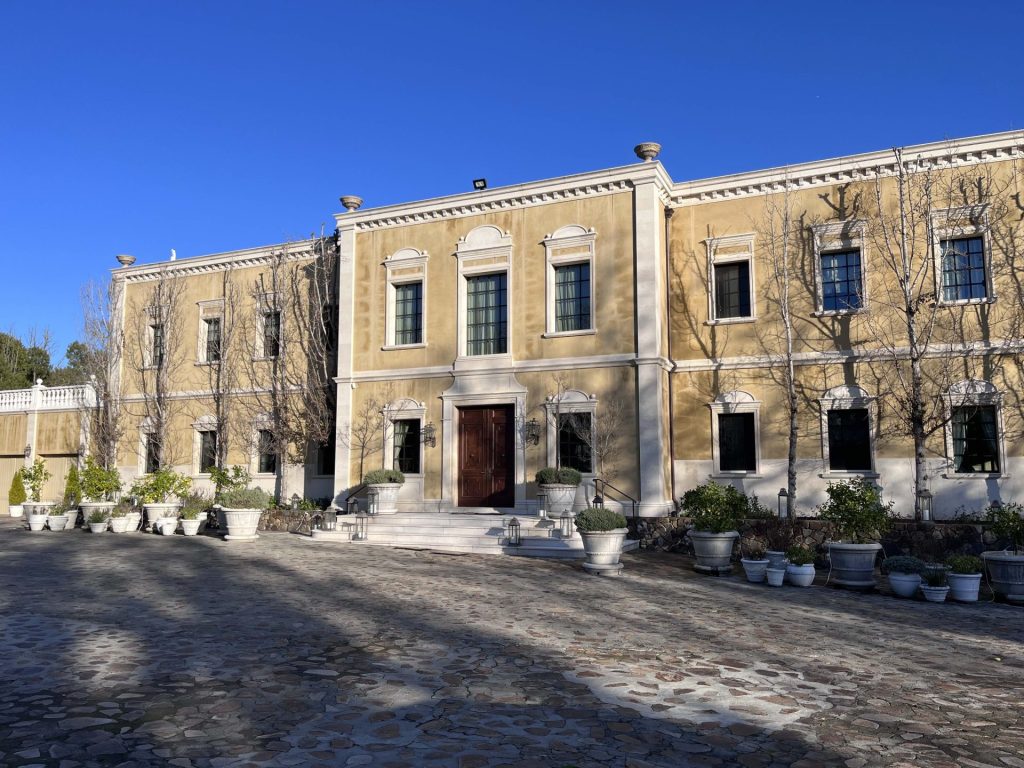
The scene of the crime, the home of our very gracious host, Don Sebastiani Sr. of Sonoma. My thanks as always to Keith Casale, CFO of Landers Curry, who assisted Don (and me) in organizing this tasting.
Chicken Murder, Bobcat style

Went for the usual collection of chicken eggs at dusk, found this sad scene of feathers but no chicken – one of the most productive and peaceful of our flock – a Buff Orpington chickens was killed. Looks like it was pulled through a hole in the fence and dispatched just outside the coop door. This might be the first time a bobcat has taken a chicken. For us, it’s usually the hawks.
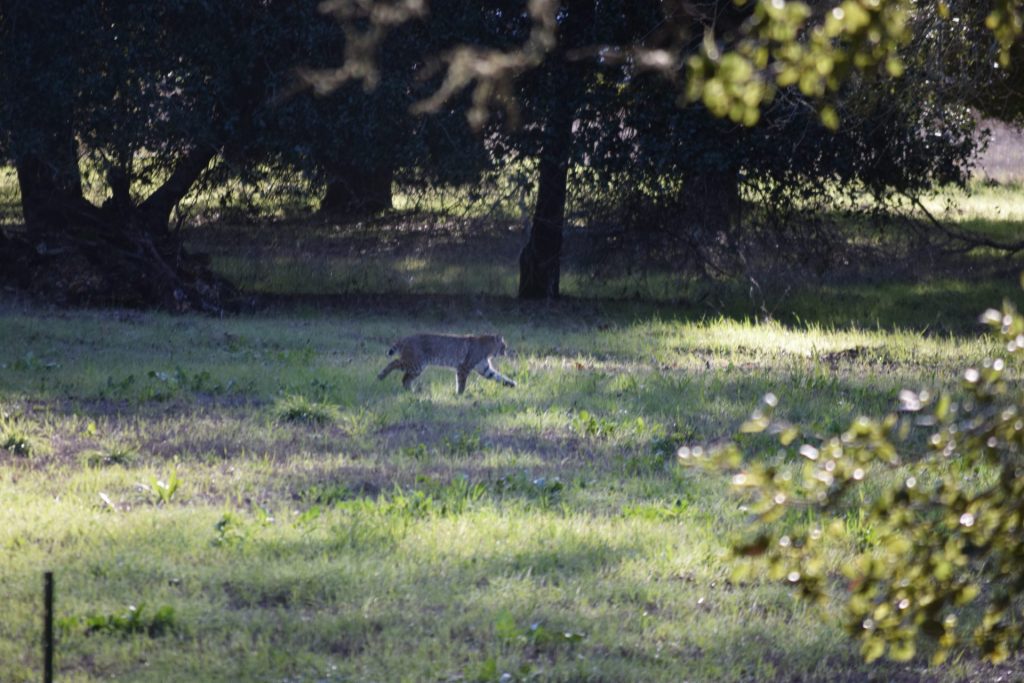
The likely fugitive from justice, a really gorgeous Bobcat crossing from the chicken coop to the vineyard. Note the telltale striping on the front left leg.
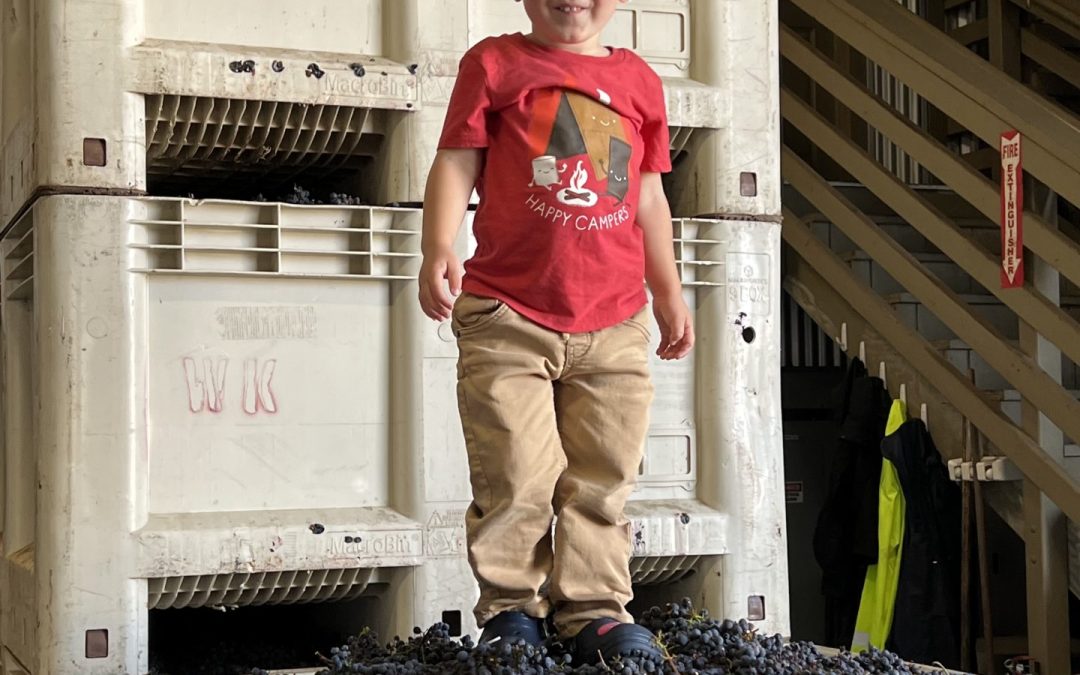
Oct 22, 2022 | Uncategorized, Hydeout Sonoma, Sonoma, Sonoma Farming, Vineyard
Passing the 1,000 blog readers mark, and with my thanks to you all, here are 50+ images from this, my 23rd vintage. – Ken Wornick
Blending trials for bottling aged reds prior to harvest
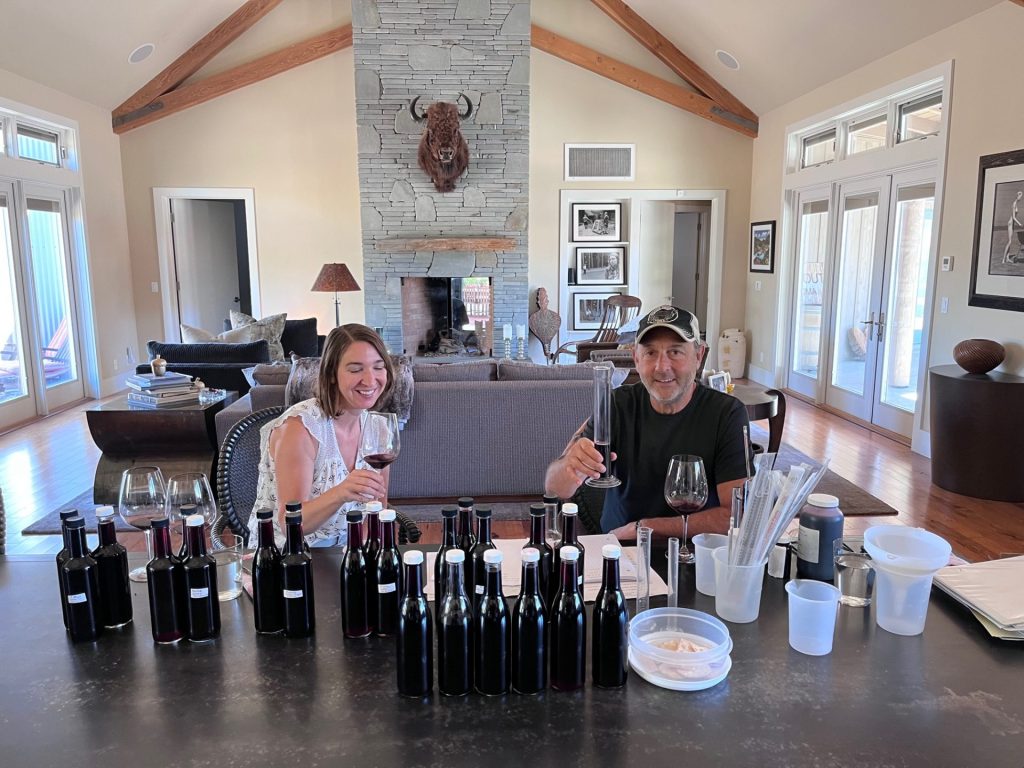
Faith and I needed to plan the bottling of the remaining 2020 client red wines that were still aging in barrels. To get ready, we conducted blending trials for some of our client wines here at the Hydeout Sonoma kitchen table.
Note the grouped samples as source wines, the pipettes and beakers, and so on. We start with the base wines, tasting notes, and lab chemistry in hand. Then we try to imagine what actions will give lift, depth, and longevity to each wine. Blending is a fun process because after spending a year growing the fruit and another year producing and yet another year aging the wines, it is really nice to sit in a warm quiet well-lit place and taste each wine one last time with focus and concentration. And then somehow with a bit of alchemy, create delicious artistry from all of the components.
Bottling
While the 2021 vintage continues to age in barrels, and the 2022 harvest approaches, emptying barrels of perfectly-aged and blended 2020 red wine for bottling also creates needed space in the winery for the incoming 2022 vintage.
One of the best days for what we do is delivering a completed bottled vintage to our clients, sometimes 26 months of waiting! Here are 3 recent examples:
4:00am start on an early morning in August, 2022
Harvest 2022 started for us in mid-August with some client hillside fruit on Arrowhead Mountain in southern Sonoma. What a moment it is every year when we shift from farming, which started way back in January, and finally seven to nine months later the fruit is ripe and we’re ready to harvest.
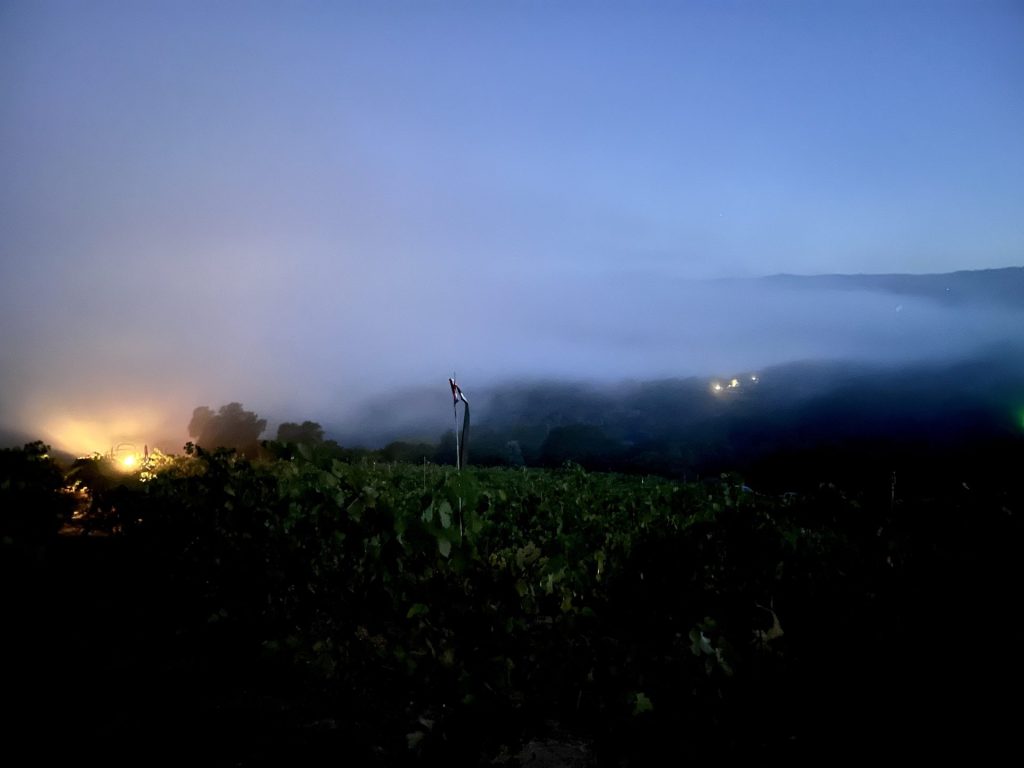
A cool dense layer of fog sits on the valley floor below this vineyard block, as the slowly approaching tractor lights glow in the background

A slight breeze and the fog suddenly shifts as the sun almost rises (note the 3 house lights down below no longer in fog)
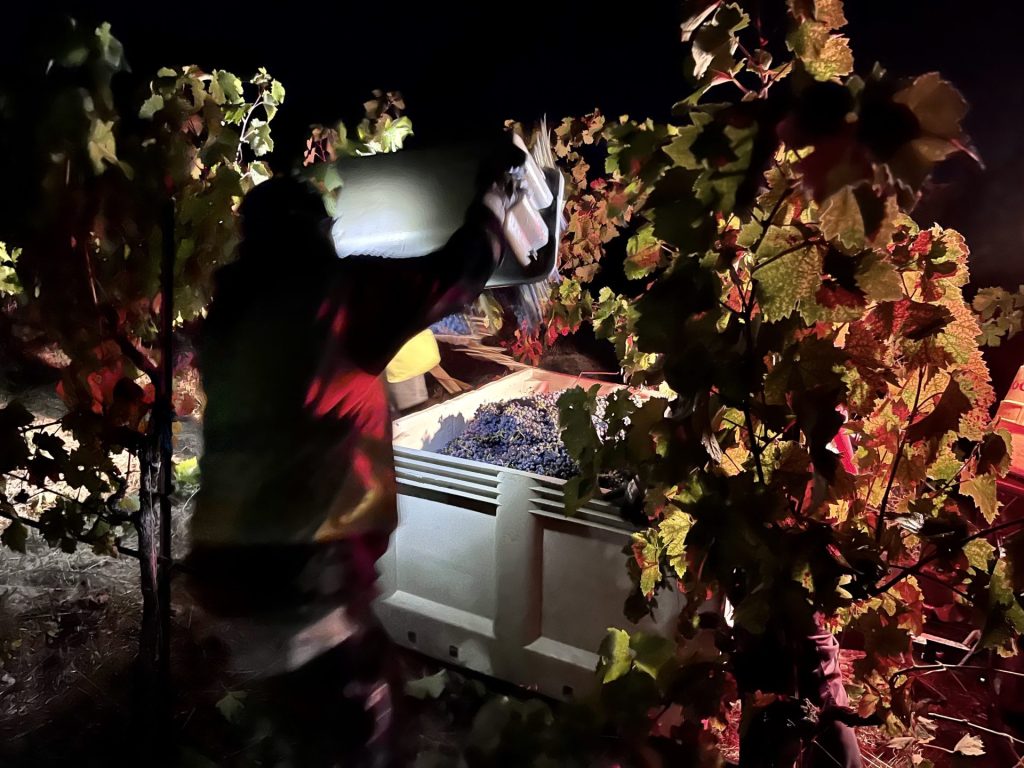
But it’s still dark inside this vine canopy as fruit fills the 1/2 ton bins of Zin

A bobcat grabs more empty bins and rushes them into the field

And minutes later returns with full bins of fruit. These bins are then rushed to the winery; we want that fruit to be ice-cold when it arrives.
Click here to watch a video of a night harvest

My next stop is to check out a client’s Eastside Sonoma Valley Pinot Noir vineyard scheduled to pick in the following few days. Note the dark tight-fisted bunches as is the nature of Pinot Noir.
I can never resist picking up oak acorns. Every year, I start another crop of oak seedlings from acorns, for planting around the Hydeout ranch. Some of the most impressive oak trees and their falling acorns surround vineyards in Sonoma. And those majestic beauties produce some amazing acorns that one day will themselves be majestic oak trees.

Another harvest a few days later. Ready to drive a load of Sonoma Mountain Cabernet Sauvignon to the winery.

We start in the early morning hours and we look up and suddenly we realize the sun is out and it’s warm outside. Here, a moment of pause to celebrate the process of harvested grapes with Hydeout Sonoma partner and winemaker Faith Armstrong.
Processing fruit in the winery
Growing and harvesting great fruit is only half the battle. Next up is the winemaking. Every load of fruit is very carefully weighed, by law, so that each client’s property can be carefully tracked all the way into bottle; every single drop.

The first few bins of Pinot Noir from another early morning harvest go onto the scale

Moving into September, the long slow harvest continues to roll along as tank after tank fills with fermenting fruit. Here, happy winemakers about to get started on some pristine Zinfandel

In early October, processing some Syrah from Kenwood into a 7-ton tank. The fruit from this vineyard is just across the street from Landmark Winery in Kenwood.
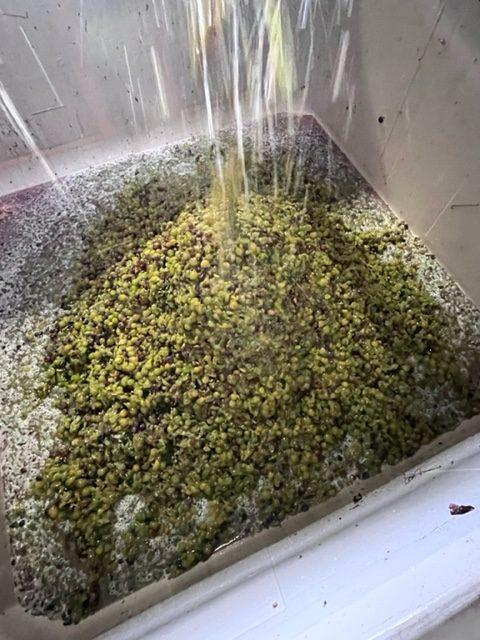
Muscat Canelli is not a very well known wine, but we love it. There are so many beautiful and under-appreciated grape varieties across the globe. This Muscat, from the Carneros Appellation in the Hyde-Burndale neighborhood, is packed full of tropical fruit and incredible peach aromatics.
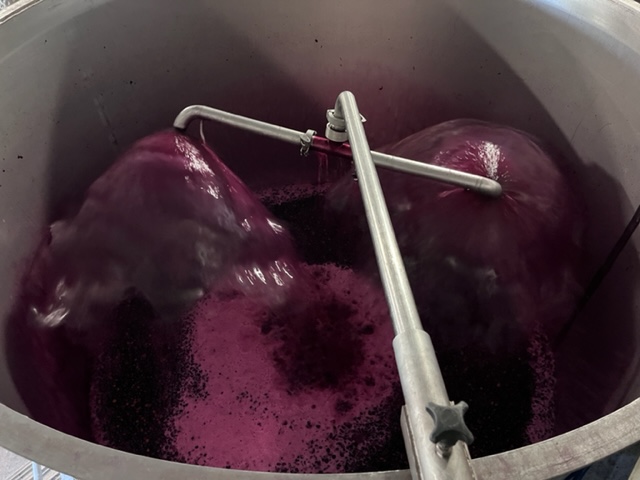
Irrigating a tank a of Grenache, a process where the fermenting juice is pumped from the bottom of the tank and “irrigated” (and oxygenated) over the top of the “cap” (the fruit floating to the top and pushed there by the expanding CO2 gas), thus encouraging the yeast to thrive and to keep the cap wet (because if it dries out, bad things can happen like the formation of vinegar).
Click here to watch a quick video of “irrigating” the cap

Now mid-October, and we’re still at it. Here, clean de-stemmed fruit accumulating in a bin, headed to a fermentation tank in a moment

The stems accumulate after the fruit has been removed for winemaking
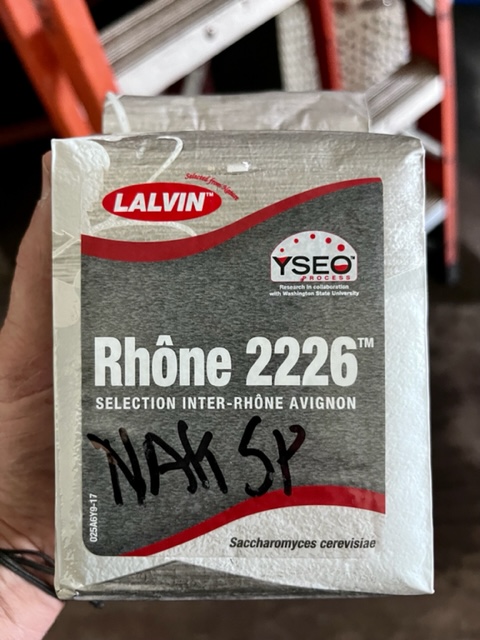
After the fruit is moved to a fermentation tank, and lab reports have been studied, we re-confirm our goals for the wine. Carefully selected yeast is added to get the fermentation rolling. In this case, a yeast from the Rhone region is specially selected for Syrah and Grenache which are Rhone varieties.
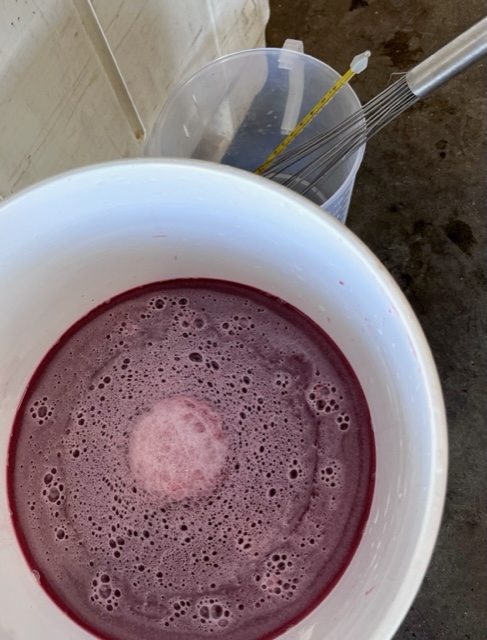
The yeast is very carefully rehydrated, and then slowly small amounts of cool raw grape juice is added and the yeast cells adjust to the temperature and awaken.
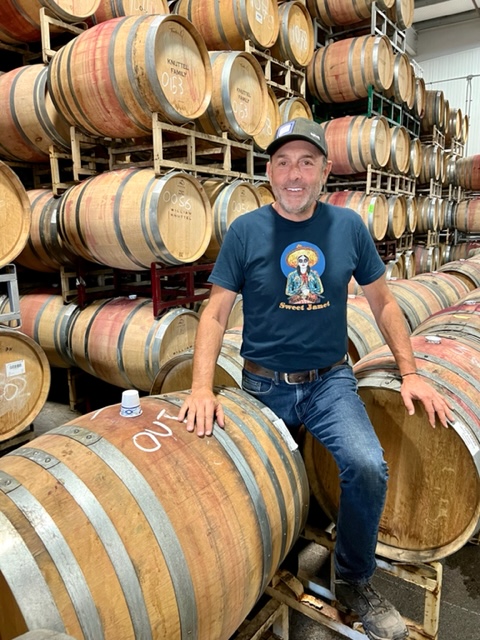
Lots of oak barrels must be prepped because soon enough, all these tanks of wine will complete fermentation and, one by one, those wines must be quickly moved into barrels where the long aging cycle begins. (footnote: T-shirt was a gift from Chewy, my Desert Caballero ace cowboy buddy)
Pizza party at the Winery, at about the halfway point, 6 weeks in and about 6 weeks to go…
Exhausted but happy, a moment of pause for some local Mary’s Pizza with the awesome winery team. Pacifico (yellow cans) was the beer of choice for all on this day – except of course for one of the guys who always wisely choses a Coors Light…see the empty seat…yup…I made the right choice!

The team at Arcana Custom Crush Winery on 8th street east in Sonoma, the management and cellar crew, from left to right: Sebastian, Kate, Mat, Bill, Landon (Maverick), Miguel, Jose, Jesus

Our winery mascot, Kate’s son Landon, welcomes another load of fruit by crushing it with his own feet. I like to call him “Maverick” because he looks like Tom Cruise from Top Gun, and moves around the winery at the same speed. If you’re a mom and it’s harvest time, the kids go to the “office” too and become part of the action.
Mid-October, yet another harvest, and this time breakfast is included!

Starting in on a some short rows as the sun rises

The tractor leads the way pulling bins quickly filling with fruit

This is what really pristine Sonoma Valley cabernet sauvignon looks like
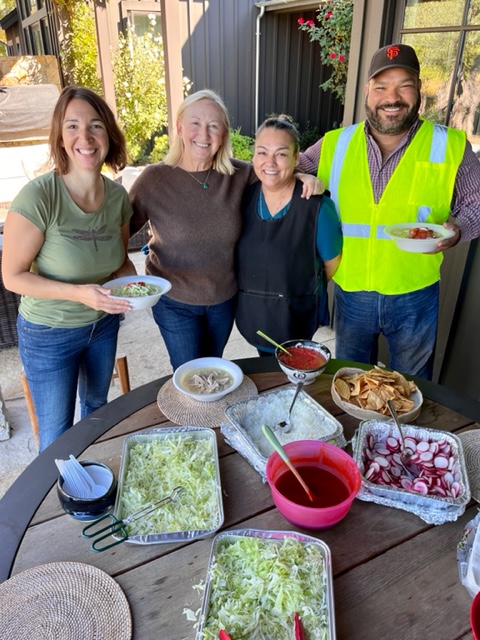
After this harvest, our wonderful client offers everyone a delicious meal. Last year was tacos and tostadas, this year was an amazing Pozole soup made of pork and hominy (the word “pozole” is thought to come from Nahuatl, the Uto-Aztecan language spoken in various forms during pre-Hispanic times).
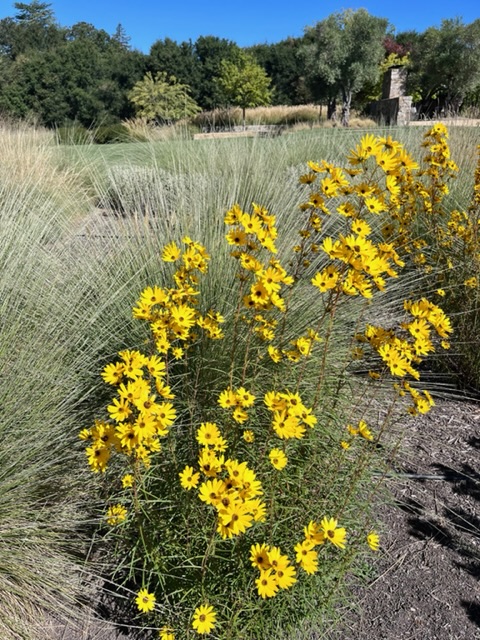
Vibrant “thin-leafed sunflower”, always blooming around Sonoma at harvest time
Jack London State Historic Park – and the Park Partners – there is always time in Sonoma for another gala non-profit fundraiser!
Jack London Park Partners emerged during a budgetary crisis in 2012 which shuttered many state parks. It was the first non-profit organization to take up management of a state park on behalf of the people of California and it has been successfully running Jack London State Historic Park ever since. If you haven’t been, please do schedule a visit. It’s very scenic and historic too.

Park Partners hosted a sold-out entertaining outdoor gala event on Sept 24th.

The staged event theme, as seen here, was “Once upon a time in a not so distant forest lived an ancient redwood tree who silently presided over her forested sanctuary.” Adults and kids, dressed up as tree and forest creatures, was totally entertaining. A real hoot!
Final Harvest of 2022 – the last fruit to ripen and the final harvest of the year – our very own Sonocaia estate Sagrantino from here at the Hydeout Ranch
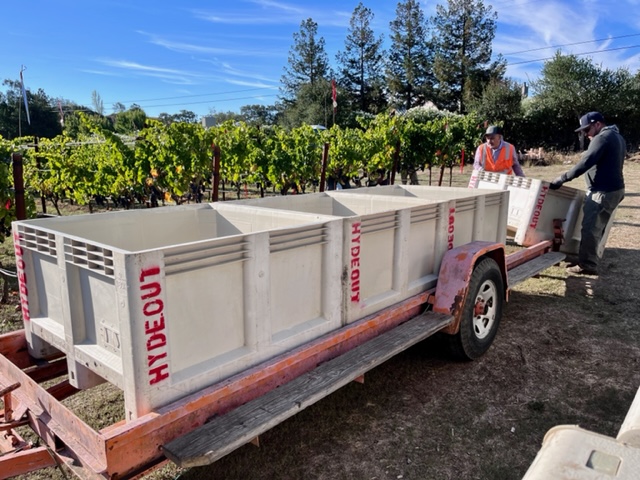
These Hydeout half-ton bins are cleaned, loaded on the skid trailer, and waiting to be filled.
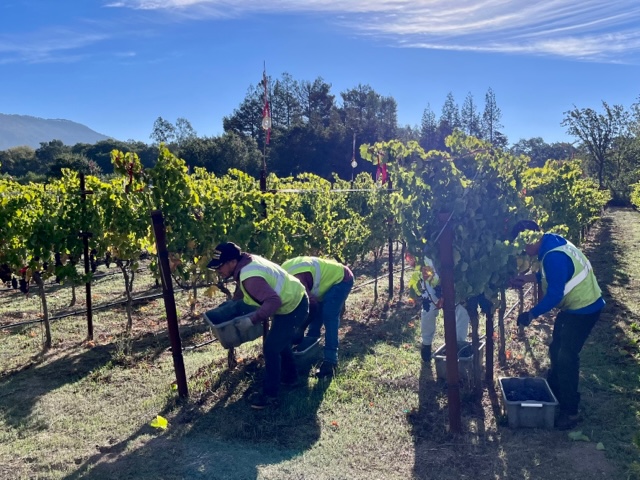
It was a very cool damp night so we waited until the sun was up and dew was off the fruit before picking, but still it was just 40F outside.

The first of several bins begins to fill, and the fruit will be on its way to the winery in moments.
Vintage 2022, you started off so perfectly, with a terrific mid-winter atmospheric river and a lovely mild spring and summer, but then you turned on us and cooked us to a crisp for five days at +110F, and then you rained more than inch on us, and then it turned cold. Just another hah hah season in wine country.

The final lug of 2022 grapes, our inky tight-bunch Sagrantino…ahhh! We’ll start pruning all the vines in February and the process repeats yet again.
If you are still reading?…
Late into October 2022, and the first of our client’s harvested grapes (from late August harvests) have completed fermentation. We’ve pressed the wines off, settled in tank, and now it’s time to barrel them down and put these wines to bed for the winter:
A final acknowledgement – Nunez Vineyard Management:
I first met Mike Nunez and his family, of Nunez Vineyard Management, going all the way back to when we opened La Honda Winery in Redwood City more than 20 years ago. A client of Mike’s who owned a vineyard in Sonoma sent his fruit down to us to process. That year, the fruit was harvested late and we ended up making a beautiful port wine. Mike drove the fruit down himself. I met him at our loading dock. We’ve been friends and colleagues ever since.
The Nunez family has deep roots in both Sonoma and Napa. We partner with them on many client projects, and our combined knowledge and experience creates a great outcome for everyone.
And, everyone involved in the growing of grapes and making of wine is publicly acknowledged at this Nunez Vineyard Management harvest party. A class act!
Next year, I think it will be fun to post a blog looking back over my 23 vintages. For now, here is a sneak peek looking back to the year 2000, and the founding of La Honda Winery, in Redwood City:
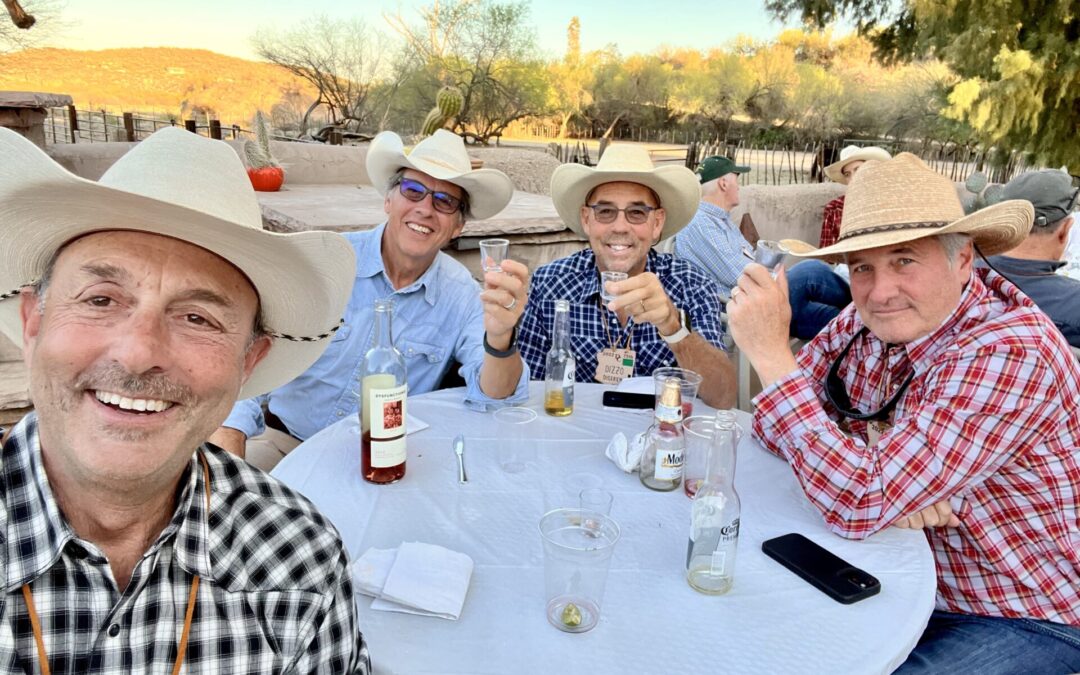
Sep 19, 2022 | Sonoma harvest 2022, Dysfunctional Family Winery, Sonoma International Film Festival, Uncategorized
After religiously posting every month for several years, it’s been nearly five months since I last posted.
Below are some brief stories about farming, the Sonoma Int’l Film Festival Summerfest, and a local Rodeo.
In the next few Sundays, we’ll look at Sagrantino through the lens of our trip to Umbria Italy. Then we’ll have a look at a professional blind Sagrantino tasting. And after that, a look at the 2022 harvest. Enjoy…
Farming in summer

By late summer, our Sagrantino vineyard can be a bit of a sprawl as the long days and warm weather inspire a growth spurt in canopy and shoot length. Not only unsightly, it also tends to shade the fruit from sun and trap air movement. So a clean up is in order.

After shoots are trimmed and positioned into the canopy wires, and lower leaves are removed around the fruit zone on the north facing side of each row, the vines are now well positioned to ripen fruit late into the fall.
Sonoma International Film Festival – Summerfest
One of the truly fun annual events in Sonoma is the Sonoma International Film Festival. Our next festival kicks off on March, 22-26 in 2023. Meanwhile, the Festival held a weekend-long “Summerfest” in early August with films during the day and films and dinners and parties at night. Here is a quick look:
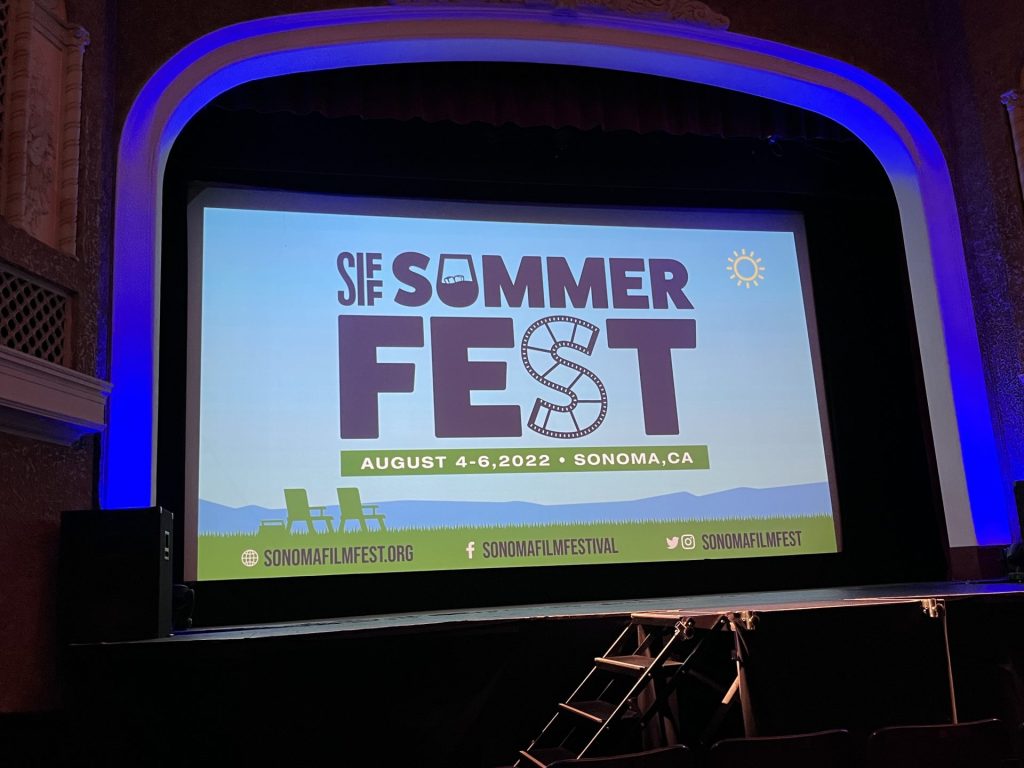
Summerfest started with a grand launch at the Sebastiani Theater.

An outdoor film screening, food trucks, and fabulous wine – on the lawn at Chateau St Jean Winery
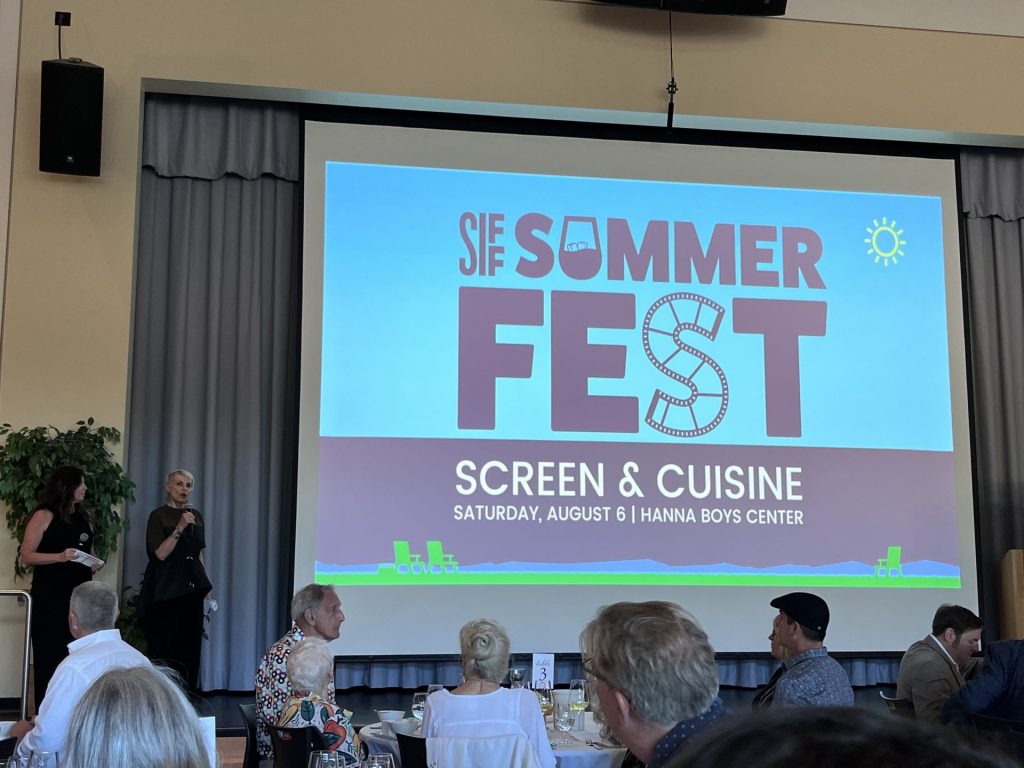
Sit down dinner and a movie – “screen and cuisine” – at the Hanna Boys Center. The movie, a biopic of noted chef and restauranteur Charlie Trotter, was moving, controversial, and entertaining.
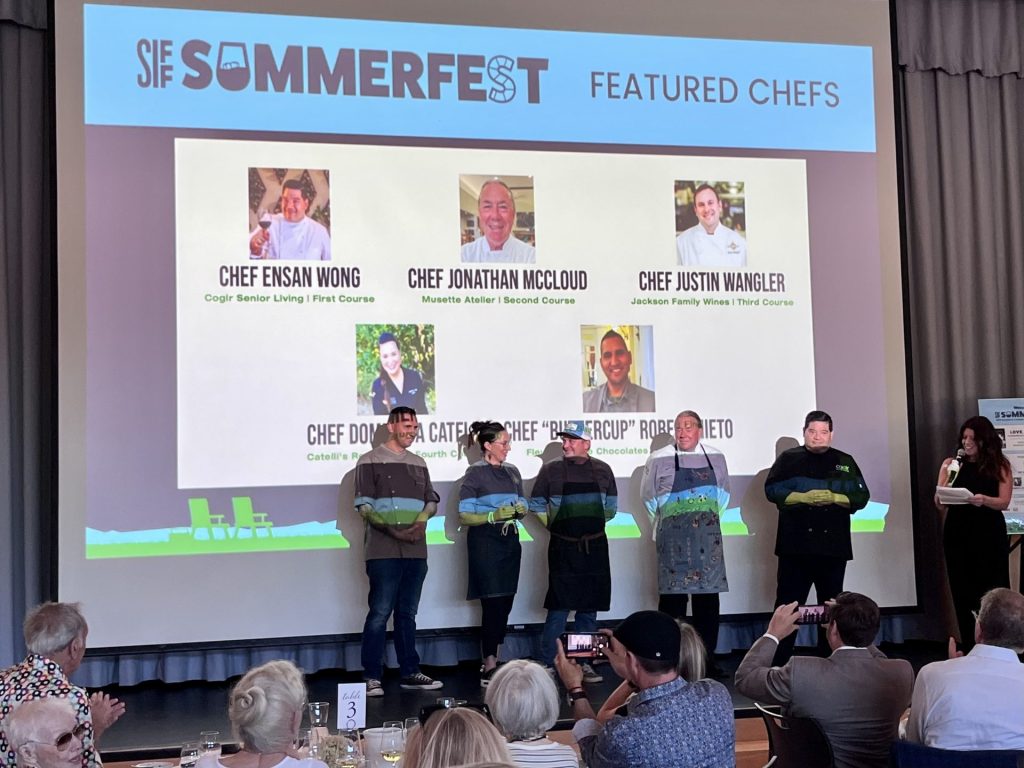
Before dinner service, the crowd celebrated the five chefs and their wonderful and creative menus
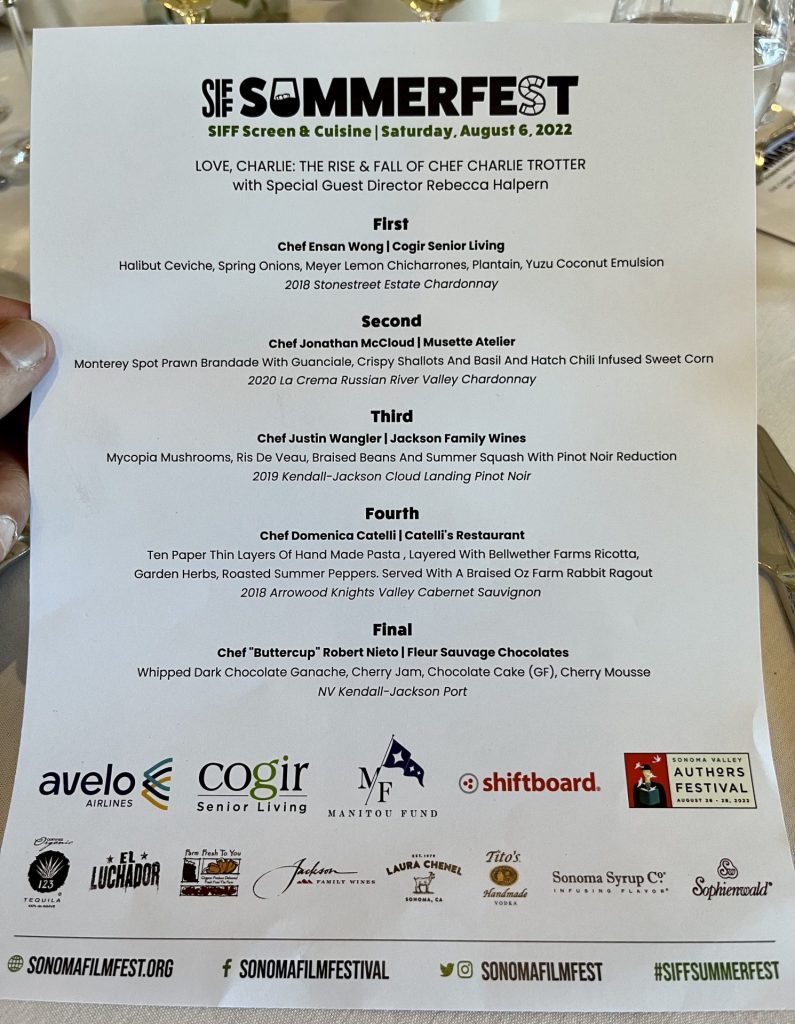
The complete menu from the nights event, along with wine pairings, and key sponsors
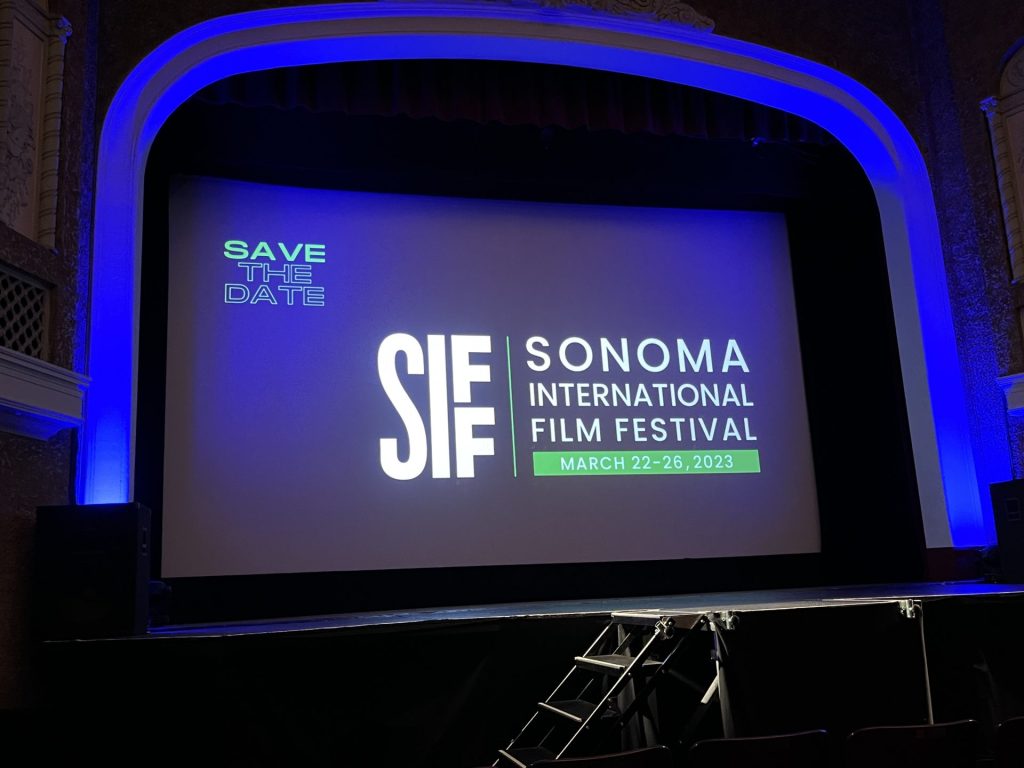
Buy your tickets now for next spring’s Film Festival, March 22-26, a totally “walkable” festival on the square in Sonoma town – https://sonomafilmfest.org
Rodeo at Wing and Barrel
Seems like there is nothing more all-american than a rodeo, especially when it starts with someone jumping out of any airplane with a giant American flag, and sticking the landing right in the middle of the paddock!

The event was held at Wing and Barrel, set on a 1,000 acre hay ranch few minutes south of Sonoma. W&B is a membership facility designed with a hunter’s sensibilities and a connoisseur’s palate “catering to discerning sportsmen, women and their families.”
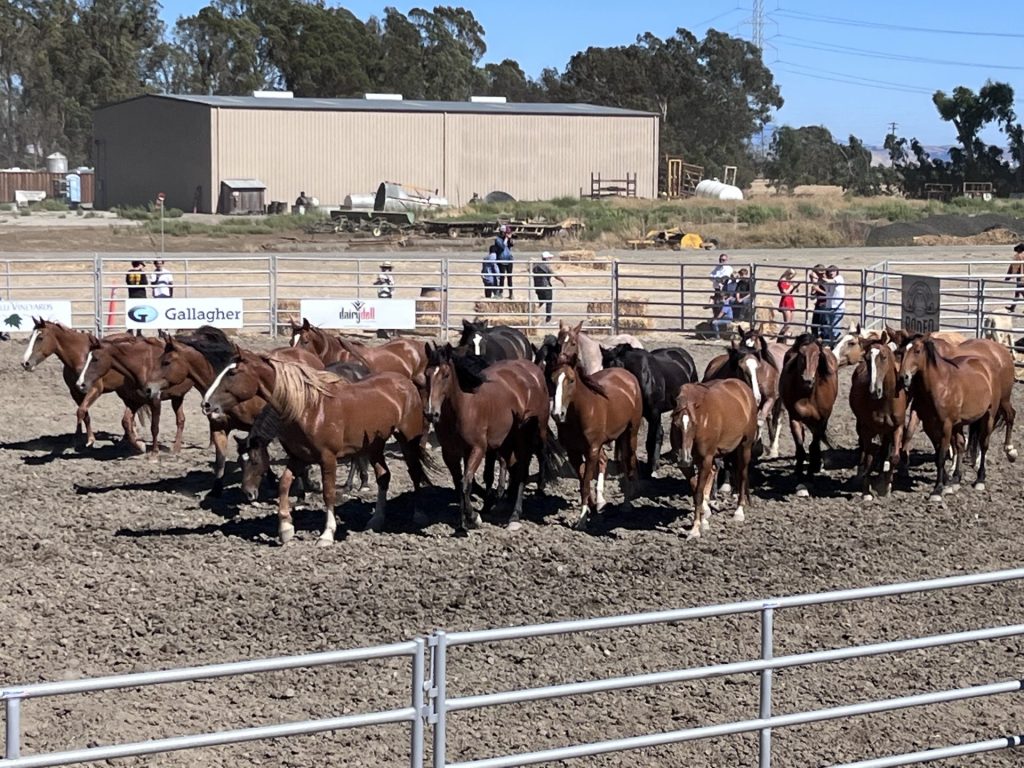
The Rodeo got started with a roundup of the horses into the large corral. All of the cowboys and cowgirls were gathering their gear, stretching out, and getting ready to compete.
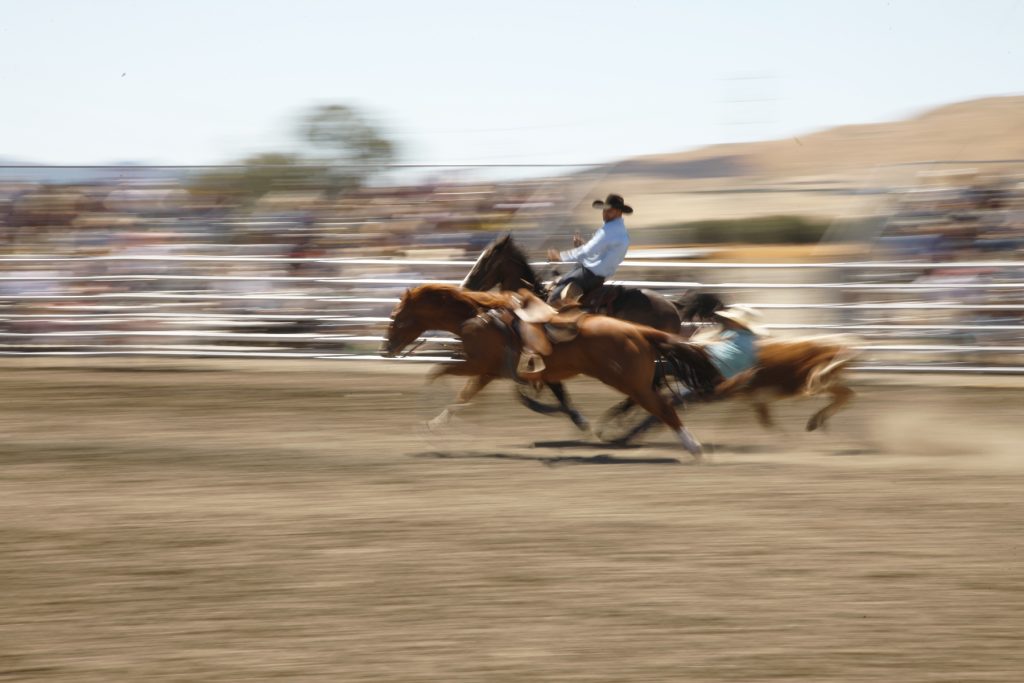
The action lasted all afternoon. Incredible talent that can only be developed when you spend your childhood, or a lot of time, or both, around horses. Photo credit: local Sonoma artist and photographer Jock McDonald https://www.jockmcdonald.com

Our group of rodeo clowns, during a stop at the Wing and Barrel bar, heading out to the rodeo. Our generous hosts, Jon and Christine Curry, 3rd and 4th from left.
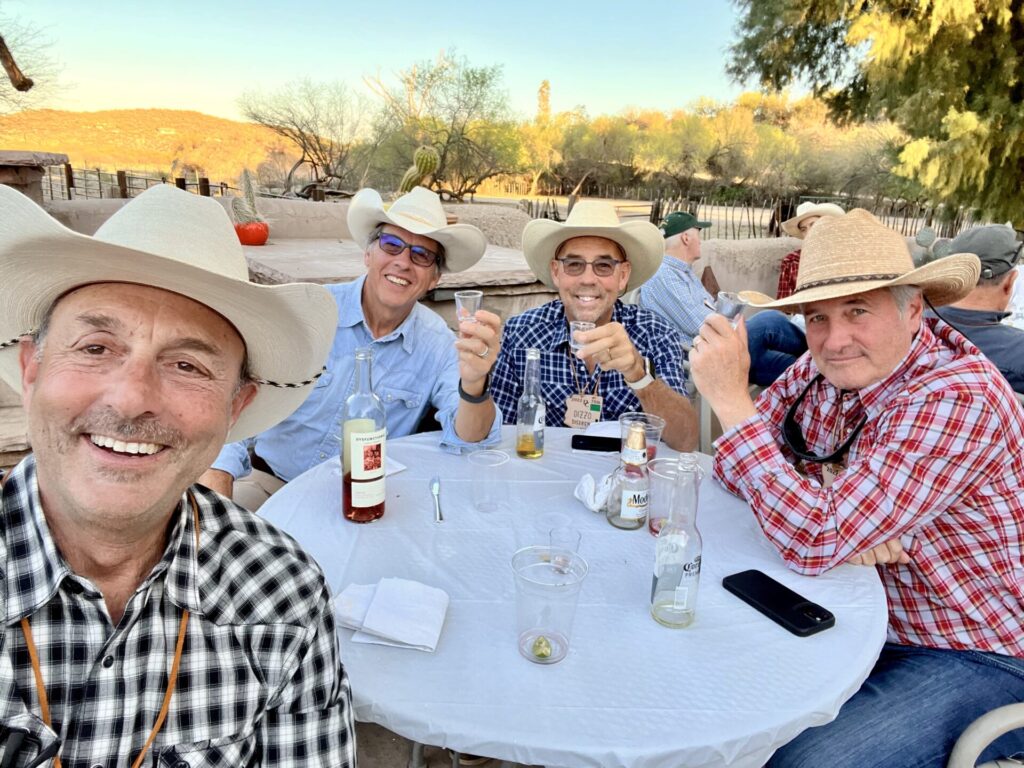
Enjoying some Dysfunctional Family Winery rosé, and beer, and tequila
In the next few Sundays, we’ll look at Sagrantino through the lens of our trip to Umbria Italy. Then we’ll have a look at a professional blind Sagrantino tasting. And after that, a look at the 2022 harvest.



























